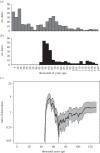What caused extinction of the Pleistocene megafauna of Sahul?
- PMID: 26865301
- PMCID: PMC4760161
- DOI: 10.1098/rspb.2015.2399
What caused extinction of the Pleistocene megafauna of Sahul?
Abstract
During the Pleistocene, Australia and New Guinea supported a rich assemblage of large vertebrates. Why these animals disappeared has been debated for more than a century and remains controversial. Previous synthetic reviews of this problem have typically focused heavily on particular types of evidence, such as the dating of extinction and human arrival, and have frequently ignored uncertainties and biases that can lead to misinterpretation of this evidence. Here, we review diverse evidence bearing on this issue and conclude that, although many knowledge gaps remain, multiple independent lines of evidence point to direct human impact as the most likely cause of extinction.
Keywords: archeology; climate change; human impacts; palaeoecology; prehistory; quaternary.
© 2016 The Author(s).
Figures


 indicates evidence for linear trend) across sampling intervals of increasing width; also shown is the mean trend slope (β) per sampling interval width; (b) example EPICA temperature series resampled at a constant window of 600 years from present back to 450 ka; and (c) average and 95 percentile mean deviation of temperature within the four interstadials since 450 ka.
indicates evidence for linear trend) across sampling intervals of increasing width; also shown is the mean trend slope (β) per sampling interval width; (b) example EPICA temperature series resampled at a constant window of 600 years from present back to 450 ka; and (c) average and 95 percentile mean deviation of temperature within the four interstadials since 450 ka.
References
-
- Wallace AR. 1876. The geographical distribution of animals, with a study of the relations of living and extinct faunas as elucidating past changes of the Earth's surface, vol. 1. New York, NY: Harper and Brothers.
-
- Lima-Ribeiro MS, Hortal J, Varela S, Diniz-Filho JAF. 2014. Constraint envelope analyses of macroecological patterns reveal climatic effects on Pleistocene mammal extinctions. Quat. Res. 82, 260–269. (10.1016/j.yqres.2014.02.003) - DOI
-
- Bartlett LJ, Williams DR, Prescott GW, Balmford A, Green RE, Eriksson A, Valdes PJ, Singarayer JS, Manica A. 2015. Robustness despite uncertainty: regional climate data reveal the dominant role of humans in explaining global extinctions of Late Quaternary megafauna. Ecography 38, 1–10. (10.1111/ecog.01566) - DOI
Publication types
MeSH terms
LinkOut - more resources
Full Text Sources
Other Literature Sources
